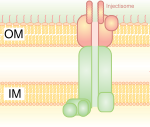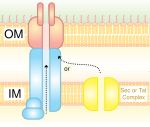It would probably be more like comparing the fuel injection with the whole engine.
Even better. Injection devices preceded fuel injected engines. So they didn't have to be invented all at once.
The The bacteria flagellum is made from more than 50 genes, 10 of those genes are found on a plasmid, which make the type 3 secretion system.
One explanation, the one Miller asserts, is the flagellum evolved from the type three secretion system.
Evidence is important, yes.
The problem with that is it ignores the type three secretion system is for infecting eukarotes, while the flagellum is for motility in water.
Much the way that injectors are for pumping liquid, while engines are for turning driveshafts. And yet...
Water has been around much longer than eukarotes. At best it could be said it is one possible step but nowhere near a complete evolutionary path.
But, as you see, it puts an end to the notion of the "irreducibly complex" bacterial flagellum." But it's not just this particular bit of evidence. There are different levels of complexity in known bacterial flagella, so there is more than one reason we know it's not what Behe assumed it to be.
Even worse, exaption means that irreducible complexity can evolve.
Another explanation, is the type three secretion system arose from the flagellum.
Which would also destroy the idea that the flagellum is irreducibly complex, since an extreme simplification would leave the system still functional.
The genes to make the type three secretion system are found large virile plasmids.
I have a degree in bacteriology, and I've never seen a virile plasmid.
By contrast the flagellur genes are not found on plasmids and there is no evidence of horizontal transfer.
Perhaps you don't know what "plasmid" means.
It's more likely the flagellum existed from the beginning, since it provides motility in water, and the TTSS was an adaptation from a horizintal gene transfer after eukaryotes arose.
As you see, there is no such thing as "the flagellum." There are various levels of complexity in different bacterial flagella. And of course, the simplest level isn't even a flagellum.
Surprise. One of a series of different kinds with differing degrees of complexity. Not irreducibly complex at all.
Why should that be surprising that there's several types of secretion systems?
And as you see, they aren't irreducibly complex, either.
There is no evolutionary relationship between those types
It would be good if you provided some evidence for that belief.
it's like saying we have types of limbs or digits.
As you know, genetic, anatomical, and fossil evidence show that all tetrapod limbs are homologous, and derive from a common ancestor.
I mentioned irreducible complexity in the type thre secretion system because it functions as a sensor, a gate, and a pump. Although little is known about these functions, so it may be premature of me to call it IC.
Erroneous.
It's irreducible complexity has already been proven by Scott Minnich's experiments. He knocked out parts of the system and it failed.
If you pull a single stone out of a Roman arch, it wall all fall down. This proves, by Minnich's logic, that all the stones in a Roman arch were inserted instantly at the same time. Or maybe he's missing something...?
The example of the Roman arch implies there is scaffolding necessary to build an arch.
Would you like some examples of biological scaffolding?
They knew what they wanted to build. They had an end in mind. They built scaffolding necessary to achieve that goal.
It works by natural selection, too.
The Roaman arch is an example of intellignt design.
And the blood clotting system is an example of evolution. Behe himself admits this, now, although he still thinks God isn't sharp enough to do it without stepping in to tinker with it now and then.
The fact is, he's wrong about the clotting cascade being irreducibly complex. Aganthans have a simpler, system; some of the steps are missing.
And very primitive chordates have an even simpler system; their low-pressure circulation can clot (as can ours) by mere protein denaturation, which entangles blood cells and makes a clot. That is generally not adequate for major trauma in humans, but it's why people lacking the usual function don't bleed forever from small cuts.
The scaffolding of an earlier system permitted a more advanced system to evolve.
Natural selection doesn't have a "goal" in mind, it selects functional systems over non-fuctional systems. There are no functional precursors to the bacteria flagellum.
As you learned, there are. And they are themselves completely functional. And of course, the different levels of complexity in bacterial flagella (there is no such thing as "the bacterial flagellum") show that it evolved over time in a series of steps.
Innovations or new functions have to exist in order to be selected.
Yep. But as you learned, exaption can produce new functions without any intent or planning. Would you like to learn how that works?
Natural selection doesn't pick things based on what they might do or could be or might eventually function.
Even Behe admits exaption is a fact.
Exaption is like saying a cell had a goal in mind and built a new system by modifying other available parts.
Nope. That's wrong. Exaption is when a feature evolved for one thing happens to work for something else.
That minimal function isn't necessary for each step or that one big step happened where several parts mutated all at the same time. We have to imagine several mutations at once, or imagine natural selection selecting non-functional systems until a final function system is obtained.
See above. God is a lot smarter than IDers would like Him to be.








